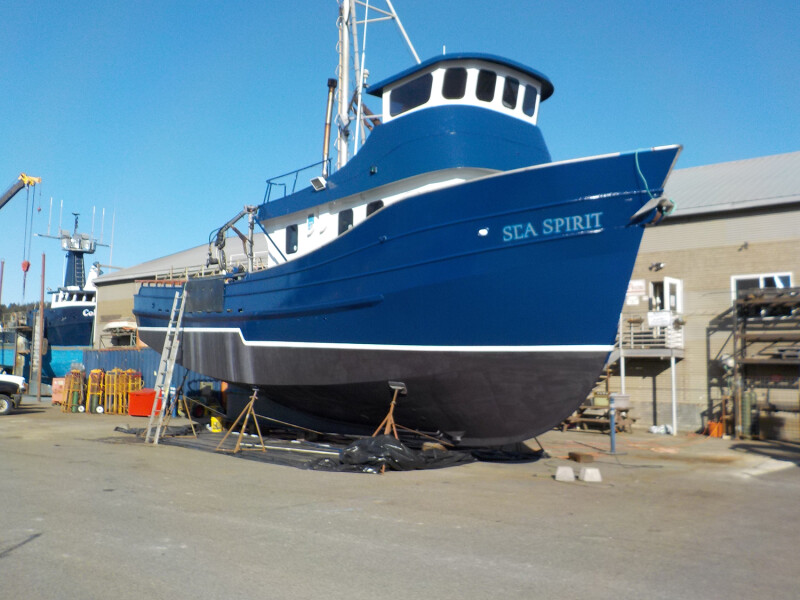Rozema Boat Works had nearly finished a 20' x 11' seine skiff in mid-April that’s going to Prince William Sound. As opposed to the three 19' x 10' seine skiffs the Mount Vernon, Wash., boatyard had previously built with the steering console in the bow, making it easier to go from side to side and hand lines off to the seiner, the new 20-footer is more traditional with the steering console mounted about amidships on the starboard side.
What’s different on this Rozema skiff is the HI500 Thrustmaster waterjet, the first waterjet that’s gone into a Rozema Boat Works seine skiff. It’s matched up with a 500-hp Cummins QSC8.3. The addition of the jet resulted in the skiff’s design being “updated all the way around,” says Rozema Boat Works’ Dirk Rozema. “The nozzle skiff wasn’t ready for a jet, so we reshaped the hull to make it jet ready.” That includes building the skiff with slightly more length and beam, giving it a constant deadrise hull, removing the tunnel for the nozzle and widening the chine. The wider chine “gives a little more buoyancy and more width, a little more side beam stability.”
An overhead view of the skiff showing the engine cover and tow post would put it very much in the nozzle skiff category, but underneath the back cover, “instead of steering is the jet,” Rozema noted. He figures the Thrustmaster and Cummins power package should generate a bollard pull in the 5,000-pound category and a top speed in excess of 20 knots.
Prior to signing the deal for the skiff, orders for new boats had been “on the slow side,” says Rozema. He attributes that to the pandemic. The building slowdown included a couple of deals for Bristol Bay gillnetters that were put on hold when the potential owners became nervous “about parts and pieces and what if something happened in the shop and we had to shut down.” But now buyer activity is picking up, and Rozema is getting calls and requests for quotes for new boats, including gillnetters. Though as of mid-April, no contracts had been signed.
At Giddings Boatworks in Charleston, Ore., the 50' x 14' crabber Sea Spirit left the week of April 19 after fabrication work was completed that’s designed to improve her safety in heavy seas.

The Sea Spirit, being a bit bow heavy, had its forward bulwarks raised 25 inches to break up boarding seas. The added height tapers back to 6 inches amidships. Then because the boat’s owner was “afraid of water breaking over the bow and busting out the windows” in the lower house, Giddings Boatworks general manager Wayne Garcia said the windows were removed and the window holes steel plated over and painted. In addition, the shaft was pulled, tuned up then reinstalled, and the cutlass bearing was replaced.
The Pacific Hooker, a 76' x 23' troller, crabber and shrimper went back in the water with a new freestanding mast Giddings Boatworks fabricated. The previous mast was “an old style gulf mast — pretty old,” says Garcia. The replacement allowed the exhaust to be moved out of the engine room and into the new mast, which freed up engine room space. Winches were also reconfigured and installed on the new freestanding mast. Below the waterline, the prop was sent away for retuning after hitting a shrimp door, which tore up the wheel’s tips.
The hull was sandblasted and painted, and the Pacific Hooker went back in the water in April.
The 71' x 22' Coho, another crabber and shrimper, came in with a “long list of items” that needed to be completed, says Garcia, much of that involved below-deck work, including gutting all the foam and fiberglass out of the fish hold. A bulkhead then went into the fish hold. Thus there are now three sections instead of two. One of those will be a bait locker. Sumps in the forward hold were reconstructed. Giddings also fabricated and installed new bin board stanchions. On deck, the Coho received new fish hold hatches with stainless steel coamings.
Giddings Boatworks has also suffered from the pandemic. Before the Sea Spirit, Pacific Hooker and Coho arrived, “for six months there was zero work,” says Garcia.
Materials are harder to get. Isocyanate spray foam for a fish hold, which is normally three days out of Seattle, could be six weeks or better, if at all, Garcia says. It’s 9 to 13 weeks for doors and windows. “All the normal stuff, the price just skyrocketed beyond belief once January struck.” Any type of stainless fitting — nuts, bolts, hatch rings — “has jumped 35-plus percent.”
Lately, one thing has been improving: “The phone won’t stop ringing,” Garcia says. Though no contracts had been signed as of mid-April, Garcia is optimistic: “Maybe we’ve got work coming.”







